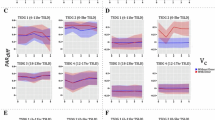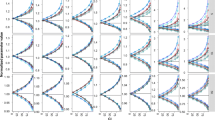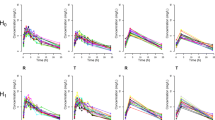Abstract
The objective of this stimulation study was to evaluate effect of simoidicity of the concentration–effect (C–E) relationship on the efficiency of population parameter estimation from sparse sampling and is a continuation of previous work that addressed the effect of sample size and number of samples on parameters estimation from sparse sampling for drugs with C–E relationship characterized by high sigmoidicity (γ > 5). The findings are based on observed C–E relationships for two drugs, octreotide and remifentanil, characterized by simple E max and sigmoid E max models (γ = ~2.5), respectively. For each model, C–E profiles (100 replicates of 100 subjects each) were simulated for several sampling designs, with four or five samples/individual randomly obtained from within sampling windows based on EC50-normalized plasma drug concentrations, PD parameters based on observed population mean values, and inter-individual and residual variability of 30% and 25%, respectively. The C–E profiles were fitted using non-linear mixed effect modeling with the first-order conditional estimation method; variability parameters were described by an exponential error model. The results showed that, for the sigmoid E max model, designs with four or five samples reliably estimated the PD parameters (EC50, E max, E 0, and γ), whereas the five-sample design, with two samples in the 2–3 E max region, provided in addition more reliable estimates of inter-individual variability; increasing the information content of the EC50 region was not critical as long as this region was covered by a single sample in the 0.5–1.5 EC50 window. For the simple E max model, because of the shallower profile, enriching the EC50 region was more important. The impact of enrichment of appropriate regions for the two models can be explained based on the shape (sigmoidicity) of the concentration–effect relationships, with shallower C–E profiles requiring data enrichment in the EC50 region and steeper curves less so; in both cases, the E max region needs to be adequately delineated, however. The results provide a general framework for population parameter estimation from sparse sampling in clinical trials when the underlying C–E profiles have different degrees of sigmoidicity.




Similar content being viewed by others
Abbreviations
- C–E :
-
Concentration–effect
- E 0 :
-
Baseline response
- EC50 :
-
Drug concentration at 50% of the E max
- E max :
-
Drug efficacy
- γ :
-
The sigmoidicity constant
- Hz:
-
Hertz
- mL:
-
Milliliter
- N :
-
Sample size
- ng:
-
Nanogram
- NONMEM:
-
Non-linear mixed effect modeling
- PD:
-
Pharmacodynamic
- pg:
-
Picogram
- PK:
-
Pharmacokinetic
References
Girgis S, Pai SM, Girgis IG, Batra VK. Pharmacodynamic parameter estimation: population size versus number of samples. AAPS J. 2005;7(2):E461–6.
Zhou H, Chen TL, Lau H, Kalafsky G, Mcleod JF. Population PK and PK/PD modeling of microencapsulated octreotide acetate in healthy subjects. Br J Clin Pharmacol. 2000;50:543–52.
Minto CF, Schnider TW, Egan TD, et al. Influence of age and gender on the pharmacokinetics and pharmacodynamics of remifentanil: I. Model development. Anesthesiology. 1997;86(1):10–23.
White DB, Walawander CA, Tung Y, Grasela TH. An evaluation of point and interval estimates in population pharmacokinetics using NONMEM analysis. J Pharmacokinet Biopharm. 1991;19:87–112.
Beal SL, Sheiner LB. NONMEM user’s guide parts I–VIII. San Francisco: University of California; 1998.
Jonsson EN, Wade JR, Karlsson MO. Comparison of some practical sampling strategies for population pharmacokinetic studies. J Pharmacokinet Biopharm. 1996;24:245–63.
Sun H, Ette EI, Ludden TM. On the recording of sample times and parameter estimation from repeated measures pharmacokinetic data. J Pharmacokinet Biopharm. 1996;24:637–50.
Al-Banna MK, Kelman AW, Whiting B. Experimental design and efficient parameter estimation in population pharmacokinetics. J Pharmacokinet Biopharm. 1990;18:347–60.
Ette EI, Howie CA, Kelman AW, Whiting B. Experimental design and efficient parameter estimation in preclinical pharmacokinetic studies. Pharm Res. 1995;12(5):729–37.
Dutta S, Ebling WF. Parameter estimability of biphasic response models. J Pharm Sci. 1997;86(1):44–51.
Pharmacokinetic and pharmacodynamic analysis with NONMEM. D. Fisher and S. Shafer, March 2007. http://www.sivauk.org/PreviousMeetings/Cambridge/Shafer%20NONMEM.pdf.
Currie DJ. Estimating Michaelis–Menten parameters: bias, variance and experimental designs. Biometrics. 1982;38:907–19.
Endrenyi L, Chan FY. Optimal designs of experiments for the estimation of precise hyperbolic kinetics and binding parameters. J Theor Biol. 1981;90:241–63.
Author information
Authors and Affiliations
Corresponding author
Rights and permissions
About this article
Cite this article
Pai, S.M., Girgis, S., Batra, V.K. et al. Population Pharmacodynamic Parameter Estimation from Sparse Sampling: Effect of Sigmoidicity on Parameter Estimates. AAPS J 11, 535–540 (2009). https://doi.org/10.1208/s12248-009-9131-2
Received:
Accepted:
Published:
Issue Date:
DOI: https://doi.org/10.1208/s12248-009-9131-2




